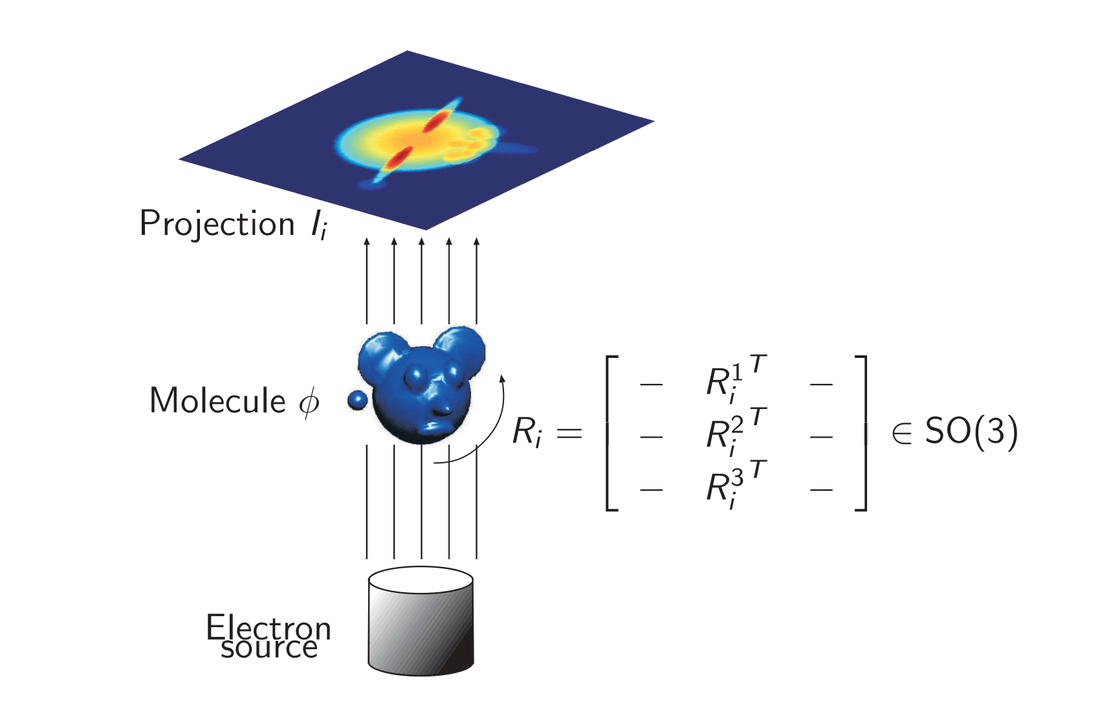João M. Pereira |
|
I am an applied mathematician studying machine
learning,
data science and multi-linear algebra. My research
centers on scalable methods and statistical
properties
of high-dimensional inverse problems, that include
tensor decomposition, scientific machine learning
and
cryo-electron microscopy. In addition, I have
interests
in machine learning, deep learning, statistics,
information theory and optimization.
I am an Assistant Professor in the Department of Mathematics at the University of Georgia. I was a Ph.D. student of Emmanuel Abbe and Amit Singer at Princeton University and worked as a postdoc with Vahid Tarokh at Duke University, and with Joe Kileel and Rachel Ward at University of Texas at Austin. Before joining UGA, I was an Assistant Professor at Instituto de Matemática Pura e Aplicada (IMPA), in Rio de Janeiro, Brazil. |
Research ProjectsProjetos de Investigação
|
Tensor
Decompositions
I develop and analyze algorithms for decomposing tensors, with special focus on symmetric and partially symmetric tensors. These tensors often arise in applications as
Relevant papers: [18] [13] [12] Recorded Talk: Method of Moments: From Sample Complexity to Efficient Implicit Computations |
Illustration of symmetric tensor
decomposition.
Credit: João M. Pereira |
|
Scientific
Machine Learning
I develop and analyze machine learning methods for learning and solving ordinary, partial and stochastic differential equations. My research includes developing new physics-informed architectures that encode key properties of differential equation solutions, as opposed to enforcing these properties through added losses, as in traditional physics-informed architectures. Relevant papers: [17] [14] [10] [9] Recorded Talk: Learning Laws of datasets |
Schematic of PINNs. The loss includes
terms that enforce
the PDE in sample points. The derivatives are
evaluated exactly and
efficiently using autograd.
Credit: Aviral Chharia et al. |
|
Fundamental Limits of
multireference alignment and Cryo-EM
Cryo-electron microscopy (cryo-EM) is a technique to determine the 3D structure of molecules. A crucial challenge in cryo-EM consists of estimating the 3D electrostatic potential of the molecule from (very noisy) 2D projections of the molecule potential, over unknown viewing directions. This problem can be seen as an instance of MRA, where the observations result from a group action on the signal, which is then corrupted with noise. I study the fundamental limits of multireference alignment (MRA) in the low signal-to-noise ratio (SNR) regime, which is the prevalent regime in cryo--EM this context. We have showed previously that the sample complexity, that is, the number of samples needed to achieve a certain level of accuracy, is determined by the lower order moments of the data. |
Single-particle reconstruction
problem in Cryo-EM
Credit: Amit Singer |
|
Pseudo-spectra of
Time-Frequency localization operators
I have a long-standing ongoing project studying time-frequency localization operators. Previously, we have used inequalities arising from the trace and norm of time-frequency localization operators to study their pseudo-spectra and obtain other important results. Moreover, we used similar ideas to show that a class of determinantal point processes, associated with the Schrödinger representation of the Heinsenberg group, belong to a state of matter called hyperuniform. |
Left: Poisson process, not uniform;
Middle: hyperuniform; Right: Lattice/Crystal, also hyperuniform. Credit: Wikipedia |
PublicationsPublicações
[18] J. Kileel and J. M. Pereira,
Subspace power method for symmetric tensor
decomposition,
Numerical Algorithms,
2025.
[preprint] [code]
[17] A. Bizzi, L. Nissenbaum, and J. M. Pereira,
Neural conjugate flows: A physics-informed
architecture with flow structure,
Proceedings of the AAAI Conference on Artificial
Intelligence, vol. 39, no. 15, pp. 15 576–15 586, Apr. 2025.
[16] M. M. Alves, J. M. Pereira, and B. F. Svaiter,
A search-free \(O(1/{k}^{3/2})\) homotopy inexact proximal-Newton extragradient
algorithm for monotone variational inequalities,
SIAM Journal on Optimization, vol. 34, no. 4, pp.
3235–3258, 2024.
[preprint] [code]
[15] L. D. Abreu and J. M. Pereira,
Orthonormal functions with prescribed time-frequency
localization,
ResearchGate
pre-print, 2023.
[14] A. Hasan, K. Elkhalil, Y. Ng, J. M. Pereira,
S. Farsiu, J. Blanchet, and V. Tarokh,
Modeling extremes with \(d\)-max-decreasing neural networks,
in Proceedings of the Thirty-Eighth Conference on
Uncertainty in Artificial Intelligence, vol. 180. PMLR, 01–05
Aug 2022, pp. 759–768.
[preprint] [code]
[13] J. M. Pereira, J. Kileel, and T. G. Kolda,
Tensor moments of Gaussian mixture models: theory
and applications,
ArXiv preprint,
arXiv:2202.06930, 2022.
[code]
[12] J. Kileel, T. Klock, and J. a. M Pereira,
Landscape analysis of an improved power method for
tensor decomposition,
in Advances in
Neural Information Processing Systems, vol. 34, 2021, pp. 6253–6265.
[11] A. Hasan, K. Elkhalil, J. M. Pereira,
S. Farsiu, J. H. Blanchet, and V. Tarokh,
Deep extreme value copulas for estimation and
sampling,
ResearchGate pre-print,
2021.
[10] A. Hasan, J. M. Pereira, S. Farsiu, and
V. Tarokh,
Identifying latent stochastic differential
equations,
IEEE Transactions on
Signal Processing, vol. 70, pp. 89–104, 2022.
[preprint] [code]
[9] A. Hasan, J. M. Pereira, R. Ravier, S. Farsiu,
and V. Tarokh,
Learning partial differential equations from data
using neural networks,
in ICASSP
2020 - 2020 IEEE International Conference on Acoustics, Speech and Signal
Processing (ICASSP), 2020,
pp. 3962–3966.
[preprint] [code]
[8] Y. Ng, J. M. Pereira, D. Garagic, and
V. Tarokh,
Robust marine buoy placement for ship detection
using dropout k-means,
in ICASSP
2020 - 2020 IEEE International Conference on Acoustics, Speech and Signal
Processing (ICASSP), 2020,
pp. 3757–3761.
[preprint]
[7] E. Abbe,
T. Bendory, W. Leeb, J. M. Pereira, N. Sharon, and A. Singer,
Multireference alignment is easier with an aperiodic
translation distribution,
IEEE
Transactions on Information Theory, vol. 65, no. 6, pp. 3565–3584, 2019.
[preprint] [code]
[6] E. Abbe, J. M. Pereira, and A. Singer,
Estimation in the group action
channel,
in 2018 IEEE International
Symposium on Information Theory (ISIT), June 2018, pp. 561–565.
[preprint]
[5] E. Abbe, J. M. Pereira, and A. Singer,
Sample complexity of the Boolean multireference
alignment problem,
in 2017 IEEE
International Symposium on Information Theory (ISIT), 2017, pp. 1316–1320.
[preprint]
[4] L. D. Abreu, J. M. Pereira, and J. L. Romero,
Sharp rates of convergence for accumulated
spectrograms,
Inverse Problems,
vol. 33, no. 11, p. 115008, 2017.
[preprint]
[3] L. D. Abreu, J. M. Pereira, J. L. Romero, and
S. Torquato,
The Weyl–Heisenberg ensemble: hyperuniformity and
higher Landau levels,
Journal of
Statistical Mechanics: Theory and Experiment, no. 4, p. 043103, 2017.
[preprint]
[2] L. D. Abreu and J. M. Pereira,
Pseudo prolate spheroidal functions,
in 2015 International Conference on Sampling Theory
and Applications (SampTA), 2015, pp. 603–607.
[preprint]
[1] L. D. Abreu and J. M. Pereira,
Measures of localization and quantitative Nyquist
densities,
Applied and Computational
Harmonic Analysis, vol. 38, no. 3, pp. 524–534, 2015.
[preprint]






